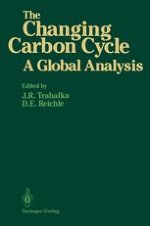
1986 | OriginalPaper | Chapter
The Global Atmospheric CO2 Distribution 1968–1983: Interpretation of the Results of the NOAA/GMCC Measurement Program
Authors : Richard H. Gammon, Walter D. Komhyr, James T. Peterson
Published in: The Changing Carbon Cycle
Publisher: Springer New York
Included in: Professional Book Archive
Activate our intelligent search to find suitable subject content or patents.
Select sections of text to find matching patents with Artificial Intelligence. powered by
Select sections of text to find additional relevant content using AI-assisted search. powered by
The modern period of precise atmospheric CO2 measurements began with Keeling’s pioneering determinations at Mauna Loa, Hawaii, and the South Pole during the International Geophysical Year. The Mauna Loa record (e.g., Keeling 1983) remains the single most valuable CO2 time series for carbon cycle model verification. For very recent interpretations of atmospheric CO2 measurements and carbon cycle relationships, the reader is referred to Cleveland et al. (1983), Keeling (1983), Machta (1983), Mook et al. (1983), Pearman et al. (1983), Keeling et al. (1984), Wong et al. (1984), Bacastow et al. (1985), Komhyr et al. (1985), and Fraser et al. (this volume). In this chapter, the global atmospheric CO2 records, particularly of the NOAA/GMCC (National Oceanic and Atmospheric Administration/Geophysical Monitoring for Climatic Change) program, are summarized for the period 1968 through 1983, with emphasis on the mean properties of the global carbon cycle as viewed from the atmosphere (i.e., global mean CO2 concentration, latitude dependence of concentration and seasonal amplitude, airborne fraction, etc.).